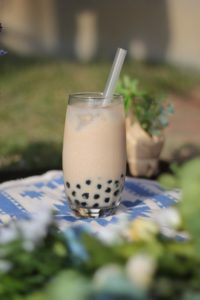
Year: 2019 and 2027
Market size: $2.1 billion and $4.2 billion, respectively
April 21st is National Tea Day in the United Kingdom. Founded in 2016 to inspire the world to drink more tea, this date was chosen because it is also Queen Elizabeth’s birthday. Worldwide, tea is the second-most consumed nonalcoholic beverage behind packaged water. National Bubble Tea Day was first celebrated on April 30, 2018, as a marketing strategy for Kung Fu Tea in New York. This bubble tea franchise currently has locations throughout most of the United States.
Today’s market size shows global revenues for the tea-based drink called bubble tea (or boba) for 2019 and projected for 2027. Bubble tea was invented in Tiachung, Taiwan in the early 1980s. Traditionally, it contained brewed tea, dairy milk, black tapioca pearls, and a sweetener such as honey or sugar. Newer varieties contain assorted flavorings and can be fresh-fruit-based. Milk-based bubble tea can contain soy milk, almond milk, or other non-dairy milk varieties. The chewy black tapioca pearls, made by boiling and steeping white tapioca pearls in caramelized sugar for hours, are what give bubble tea its name.1 There are currently more than 21,000 boba shops in Taiwan, and thousands more in North America, Europe, and other parts of Asia. Boba’s popularity began in earnest over the last decade as Instagram, the new word-of-mouth advertising, became popular in Taiwan. Since then, the variety of boba offered by shops has expanded greatly as these businesses compete to offer something new to attract customers.
Black tea held the highest market share in 2019 at 45%, perhaps because of it being the traditional tea used in the drink or because of its distinct taste. Green tea is expected to experience the fastest growth through 2027 as more people become aware of green tea’s health benefits, such as lowering blood pressure and cholesterol and decreasing the risk of certain cancers. However, boba may not be the best way to enjoy the health benefits of green tea. While the average 8-ounce boba contains just 120 calories with little to no fat, it also has 28 grams of sugar, and that’s not taking into consideration that some varieties of boba are made with pudding, yogurt, fruit, jellies, and syrups. Consumption of high levels of sugar increases one’s risk for obesity and diabetes.
Fruit-flavored boba held 37% of the market, the highest share in 2019, followed by classic and coffee flavors. Fruit-flavored boba is expected to maintain its lead through 2027 owing to shops offering a wide range of flavors such as strawberry, passionfruit, honeydew, avocado, coconut, and lychee among others to satisfy a wide range of tastes. Coffee is expected to be the fastest-growing flavor over this time period due to coffee’s popularity as a healthy energy drink especially in Europe and Scandanavia.
Not surprisingly, the Asia Pacific region is the largest market with a more than 35% share, Thailand being one of the major consumers. The average consumption in this country is six cups per person per month. Europe is expected to experience the highest growth through 2027 with the United Kingdom, Germany, and Italy being some of the countries with the highest demand in the region. North America is also expected to experience steady growth during this time period.2 Major companies are focused on expanding their presence globally and to gain market advantage are launching new flavor and tea varieties. Major suppliers in this industry include Bobabox Ltd., Bubble Tea House Co., Bubble Tea Supply Inc., Fokus Inc., Lollicup USA Inc., and Troika JC Inc. Leading bubble tea shop franchises include Gong Cha, ChaTime, T BUN International, and Ten Ren’s Tea Time.1 According to Leslie Nguyen-Okwu, a journalist based in Taipei, Taiwan, although there are differing accounts as to who exactly invented boba, “[t]he one thing that everybody agrees upon is that the name “boba” is a reference to the 1980s Hong Kong sex symbol Amy Yip, whose nickname, ‘Boba,’ is also a Chinese slang term for her most famous pair of physical assets.”
2 A surge in demand for products assembled abroad and a shortage of workers due to coronavirus cases and public health protocols have created problems in the global supply chain in 2021, leaving dozens of ships delivering goods from Asia waiting out to sea. This created a shortage of boba in the United States and Canada in the first half of the year. Fully formed boba comes from Taiwan and cassava root, which is used to make tapioca, comes from Taiwan and islands in the Pacific Ocean. Low supply has led to supplier rationing and some shops had already run out of boba by April. As Brian Tran, co-owner of Honeybear Boba in San Francisco states: “A boba shop without boba is…like a steakhouse without steak.” While some customers may leave without buying anything, it may be an opportunity for others to try new toppings in their tea. Supplies weren’t expected to return to normal until the summer. Source: Kellen Browning, “Another Unlikely Pandemic Shortage: Boba Tea,” The New York Times, April 16, 2021 available online here.
Sources: “Bubble Tea Market Size, Share & Trends Analysis Report by Product (Black, Green, Oolong), by Flavor (Classic, Coffee, Fruit), by Region (APAC, North America, Europe, MEA), and Segment Forecasts, 2020 – 2027,” Grand View Research Report Summary, June 2020 available online here; “Bubble Tea Market Size Worth $4.2 Billion by 2027 | CAGR 8.9%: Grand View Research, Inc.,” CISION PRNewswire, June 11, 2020 available online here; Leslie Nguyen-Okwu, “Boba Explained: Types of Bubble Tea, and How to Order,” Eater, March 16, 2019 available online here; “National Tea Day — April 21, 2021,” National Today available online here; “Boba Tea: Are There Health Benefits?” WebMD available online here; “Bubble Tea,” Wikipedia, February 26, 2021 available online here; Kellen Browning, “Another Unlikely Pandemic Shortage: Boba Tea,” The New York Times, April 16, 2021 available online here.
Image source: Hiroaki Kaneda, “boba-pearl-milk-tea-boba-milk-tea-4402053,” Pixabay, August 13, 2019 available online here.




 According to the National Coffee Association’s 2017 National Coffee Drinking Trends report, 62% of Americans drink coffee on a daily basis and 46% of coffee consumed is done so away from home. Although the recent popularity of coffee cafes may be traced back to the 1990s when Starbucks expanded across the country, TV show friends were seen hanging out at Central Perk coffeehouse, and laptops and wi-fi allowed workers to work from anywhere, coffee cafes are nothing new. The first public place to serve coffee dates back to 1475 in Constantinople, Turkey (now Istanbul).
According to the National Coffee Association’s 2017 National Coffee Drinking Trends report, 62% of Americans drink coffee on a daily basis and 46% of coffee consumed is done so away from home. Although the recent popularity of coffee cafes may be traced back to the 1990s when Starbucks expanded across the country, TV show friends were seen hanging out at Central Perk coffeehouse, and laptops and wi-fi allowed workers to work from anywhere, coffee cafes are nothing new. The first public place to serve coffee dates back to 1475 in Constantinople, Turkey (now Istanbul).